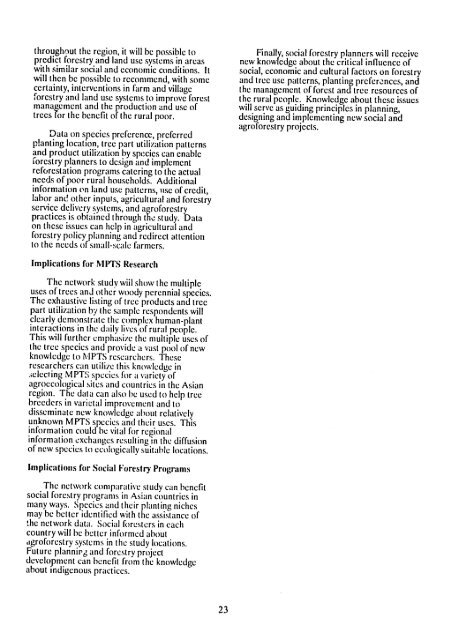multipurpose tree species research for small farms: strategies ... - part
multipurpose tree species research for small farms: strategies ... - part
multipurpose tree species research for small farms: strategies ... - part
Create successful ePaper yourself
Turn your PDF publications into a flip-book with our unique Google optimized e-Paper software.
throughout the region, it will be possible to<br />
predict <strong>for</strong>estry and land use systems in areas<br />
with similar social and economic conditions. It<br />
will then be possible to recommend, with some<br />
certainty, interventions in farm and village<br />
<strong>for</strong>estry and land use systems to improve <strong>for</strong>est<br />
management and the production and use of<br />
<strong>tree</strong>s <strong>for</strong> the benefit of the rural poor,<br />
Data on <strong>species</strong> preference, preferred<br />
planting location, <strong>tree</strong> <strong>part</strong> utilization patterns<br />
and product utilization by <strong>species</strong> can enable<br />
<strong>for</strong>estry planners to design and implement<br />
re<strong>for</strong>estation programs catering to the actual<br />
needs of lpoor rural households. Additional<br />
in<strong>for</strong>mation en land use patterns, use of credit,<br />
labor and other inputs, agricultural and <strong>for</strong>estry<br />
service delivery systems, and agro<strong>for</strong>estry<br />
practices is obtained through the study. Data<br />
on these issues can help in agricultural and<br />
<strong>for</strong>estry policy planning and redirect attention<br />
to the needs of <strong>small</strong>-scale farmers.<br />
Implications <strong>for</strong> NIPTS Research<br />
The network study wiil show the multiple<br />
uses of <strong>tree</strong>s anJ other woody perennial <strong>species</strong>.<br />
The exhaustive listing of <strong>tree</strong> products and <strong>tree</strong><br />
<strong>part</strong> utilization by the sample respondents will<br />
clearly demonstrate the complex human-plant<br />
interactions in the d;Aily lives of rural people.<br />
This will further emphasize the multiple uses of<br />
the <strong>tree</strong> <strong>species</strong> and provide a vast pool of new<br />
knowledge to MPTS <strong>research</strong>ers. These<br />
<strong>research</strong>ers can utilize this knovledge in<br />
selecting MPTS <strong>species</strong> <strong>for</strong> a variety of<br />
agrccological sites and countries in the Asian<br />
region. The data can also be used to help <strong>tree</strong><br />
breeders in varietal improvement and to<br />
disseminate new knowledge about relatively<br />
unknown MPTS <strong>species</strong> and their uses. This<br />
in<strong>for</strong>mation could be vital <strong>for</strong> regional<br />
in<strong>for</strong>mation exchanges resulting in the diffusion<br />
of new <strong>species</strong> to ecologically suitable locations.<br />
Implications <strong>for</strong> Social Forestry Programs<br />
The network comparative study can benefit<br />
social <strong>for</strong>estry programs in Asian countries in<br />
many ways. Species and their planting niches<br />
may be better identified with the assistance of<br />
.he network data. Social <strong>for</strong>esters in each<br />
country will be better in<strong>for</strong>med about<br />
agro<strong>for</strong>cstry systems in the study locations.<br />
Future plannirg and <strong>for</strong>estry project<br />
development can benefit from the knowledge<br />
about indigenous practices.<br />
23<br />
Finally, social <strong>for</strong>estry planners will receive<br />
new knowledge about the critical influence of<br />
social, economic and cultural factors on <strong>for</strong>estry<br />
and <strong>tree</strong> use patterns, planting preferences, and<br />
the management of <strong>for</strong>est and<strong>tree</strong> resources of<br />
the rural people. Knowledge about these issues<br />
will serve as guiding principles in planning,<br />
designing and implementing new social and<br />
agro<strong>for</strong>estry projects.

















